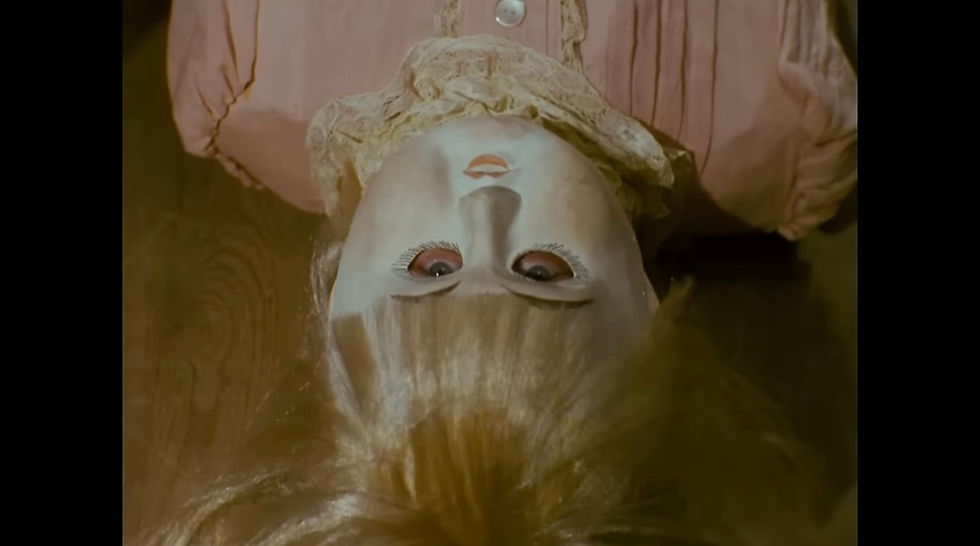Review of Švankmajer's 'Alice' (1988)
- mponc23
- 4 hours ago
- 3 min read

Happy Tuesday, everybody! I hope you all had a safe and spooky Halloweekend; I know I had a great time in the city. Last week was a hectic week for me, so I wanted to share a brief film recommendation that I think perfectly fits the sounds of Hysteria. I’m going to include some screenshots from the film and a link to the free English-dubbed movie on YouTube as well. You can expect regularly scheduled riot grrrl content next week. Thank you for tuning in—I hope you like Alice’s Adventures in Wonderland.
![[official movie poster for Alice (1988), taken from first run features]](https://static.wixstatic.com/media/43a880_7d622dd03b394c68949102ddd0020e0d~mv2.jpg/v1/fill/w_980,h_1374,al_c,q_85,usm_0.66_1.00_0.01,enc_avif,quality_auto/43a880_7d622dd03b394c68949102ddd0020e0d~mv2.jpg)
Today, I’ll be discussing the Czech film Alice (1988). It’s an intriguing piece of artwork, and I can’t help but think it evokes the distinct, messy, and girlishness female grunge is known for. The album cover for Babes in Toyland’s album Fontanelle resembles something straight out of Alice. They both also give me major I Spy and American McGee’s: Alice vibes.

There is an unsettling comfort within the sights of this dreamy Alice in Wonderland spin-off. It’s essential to note that the author doesn't intend for us to be overly disturbed, though. Scenes like this, where the White Rabbit is ordered to behead a playing card, can feel excessively cynical. Still, their eeriness becomes whittled down when paired with the familiarity of infantile fancies. Alice’s dream-home feels lived in, her dolls look loved and played with, and it never feels like we are straying too far from home.

The narrative for this movie is rather complex to follow. Not only am I not fluent in Czech, but director Jan Švankmajer also intended for the story to unfold as a dream rather than a fairy tale. This isn’t entirely evident until the end of the movie, though, where we can see our Alice wake up from a literal dream before the Red Queen orders her beheading.

While this is undoubtedly a creepy rendition of the original story we love (and that I am obsessed with), I think there is an unrecognized beauty in how comforting this film can be, despite its quirks. This attribute is something I believe various renditions of Alice in Wonderland (and the original) manage to excel at. For example, I’ve come to understand that not everybody is a big fan of Tim Burton’s Alice in Wonderland (2010). Though I’m not head over heels about it either, I really admire the film’s opening scene before Alice falls into the rabbit hole; I think that moment of calm before the storm, the moment of comfort where all is well, but you know she’s about to trip, can be comforting in itself. It’s an eerie situation, but familiar, nonetheless.
![[Tim Burton's Alice in Wonderland (2010), before she falls into the hole]](https://static.wixstatic.com/media/43a880_55cd413239b04b1cbb59c010fb98fb91~mv2.jpg/v1/fill/w_600,h_300,al_c,q_80,enc_avif,quality_auto/43a880_55cd413239b04b1cbb59c010fb98fb91~mv2.jpg)
One day, I hope to conduct a more cohesive and well-planned analysis of my favorite media that draws inspiration from Alice in Wonderland. For now, I highly recommend watching this movie. I left a link to the English dub on YouTube down below. The visuals are the primary focus, and it wouldn’t hurt to leave this on in the background while you study or write. That’s it for today; I hope you enjoy it.
Have fun in Wonderland,
Mila

_edited.png)


Comments